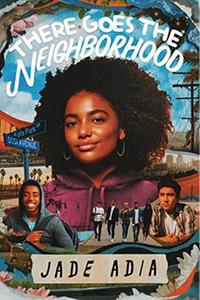
|
|
| Jade Adia | |
The American Library Association announced the 2024 Youth Media Award winners last week. Author Jade Adia's There Goes the Neighborhood (Hyperion) won the Coretta Scott King/John Steptoe New Talent Author Award, which affirms new talent and offers "visibility to excellence in writing and/or illustration."
Congratulations! How are you feeling?
Thank you so much! I'm honestly shocked that I'm now in the company of some of my favorite authors: Jas Hammonds, Tiffany D. Jackson, Amber McBride, Nicola Yoon, and Jason Reynolds have all previously won this award. As a massive fan of these storytellers, I am in disbelief to have my name on this list, too. I feel extremely lucky and grateful to the committee for seeing something special in There Goes the Neighborhood.
This title is your debut--is it a story you'd been thinking about for a long time?
Not necessarily. I had only gotten the idea for There Goes the Neighborhood a few days before I began drafting. Sometimes, writing novels is a slow burn, but other times it's a compulsion--born from a strong, unavoidable obsession to bring a story to life as soon as possible. This novel was the latter for me, so it's been incredible watching this beating heart of a story find its home in the world.
Would you tell Shelf Awareness readers what this book is about?
There Goes the Neighborhood follows 15-year-old Rhea as she reacts to the changes in her community: billboards plastered with faces of white people have cropped up, advertising the fictional Kofa Park as LA.'s "up-and-coming hot spot." And worst of all, her best friend's family is facing eviction as their landlord seeks investors to turn their apartment building into a luxury high-rise.
In a desperate attempt to do whatever it takes to stay together, Rhea and her friends orchestrate a far-out plan to scare off investors and potential newcomers by creating the illusion of gang violence in the neighborhood. To their surprise, the plan works--but a little too well. When police accuse the nonexistent gang of murder, Rhea and her friends scramble to find the real killer.
On the surface it's a wild dark comedy, but at its core it's a story about change and the sacredness of community.
 Had the idea always been to approach this story with some laughs?
Had the idea always been to approach this story with some laughs?
Definitely. I believe that it's extremely important to portray the complexity of growing up as a person of color in America. Yes, we deal with racism, but we're also goofing around with our friends, falling in love, laughing, and making honest mistakes. I wanted to craft a three-dimensional portrait of Black girlhood outside of the constraints that typically come with any sort of YA stories that deal with racism and classism.
I also believe that humor is, and always has been, an important coping mechanism for Black communities. There's a long tradition of Black creatives exploring the absurdities that arise from living in a racist state, and I wanted to play in that space as well.
How did you balance writing about weighty topics, keeping it fun, and making it approachable and entertaining for a young audience?
I tried to make There Goes the Neighborhood approachable by keeping the emotional core of the story very clear: the fear of change. I think many of us, no matter our age, can relate to this anxiety. The main character, Rhea, is experiencing an incredible amount of change all at once. She's 15 years old, she's watching her friend group change as well as her body, her feelings, her family, and--on top of it all--her neighborhood is changing, too. Writing with compassion about how change can be terrifying helped me keep the story honest. And once you're writing from a mindset of honesty and vulnerability, I think it opens a lot of space for fun.
Young people today are constantly navigating their own feelings about weighty topics in the world--whether it be gentrification, or climate change, or police brutality--while still managing to live their own messy, chaotic lives in the meantime. I guess I sort of trusted that if I told the story exactly how I would've wanted to read it as a teenager, and if I didn't pull any punches, then maybe young people today would feel seen in its pages. I'm glad that I've heard from many young readers that I made the right call tonally.
Your teen protagonists are extremely likable. Would you talk a little bit about creating this trio and their intertwined relationships?
When I set out, I knew that I wanted to have the main story be about the human cost of gentrification--to celebrate the social ties within neighborhoods that make life worth living for many folks. To tell this story, I had to give my main character, Rhea, people in her life worth fighting for. I'm so pleased that readers have responded so emotionally to this trio because I created them all from a space of love. I wanted readers not only to root for these kids, but also to experience their incredibly real and valid fear and grief at the prospect of being torn apart.
Were you able to do anything to get this book to your desired audience?
I'm so appreciative of every book festival, indie bookstore, and library who has either invited me to connect with their community or has been enthusiastically recommending the book to readers since its release. I would love to do more school events in the future. If there are any educators reading this, please do reach out!
Is there anything you'd like to add or say to Shelf Awareness readers?
Thank you so much for supporting There Goes the Neighborhood! If you're interested in more contemporary stories featuring teenagers navigating our complicated world, I hope you'll check out my upcoming book called Our Shouts Echo. It's about first love, existential dread, and doomsday prepping. Like TGTN, Our Shouts Echo is absurdly humorous at times, while deeply raw at others. I hope you enjoy. --Siân Gaetano, children's and YA editor, Shelf Awareness

